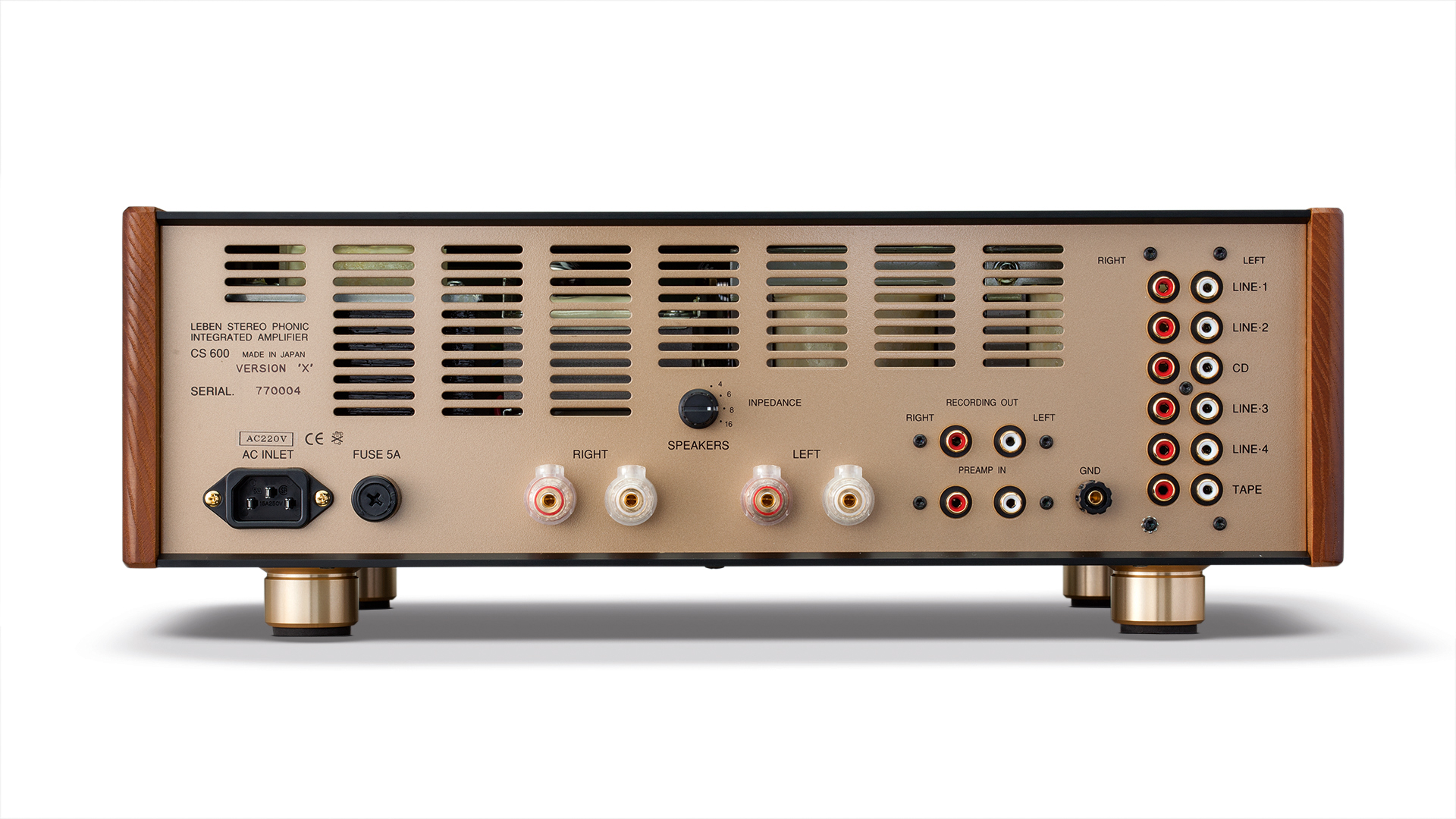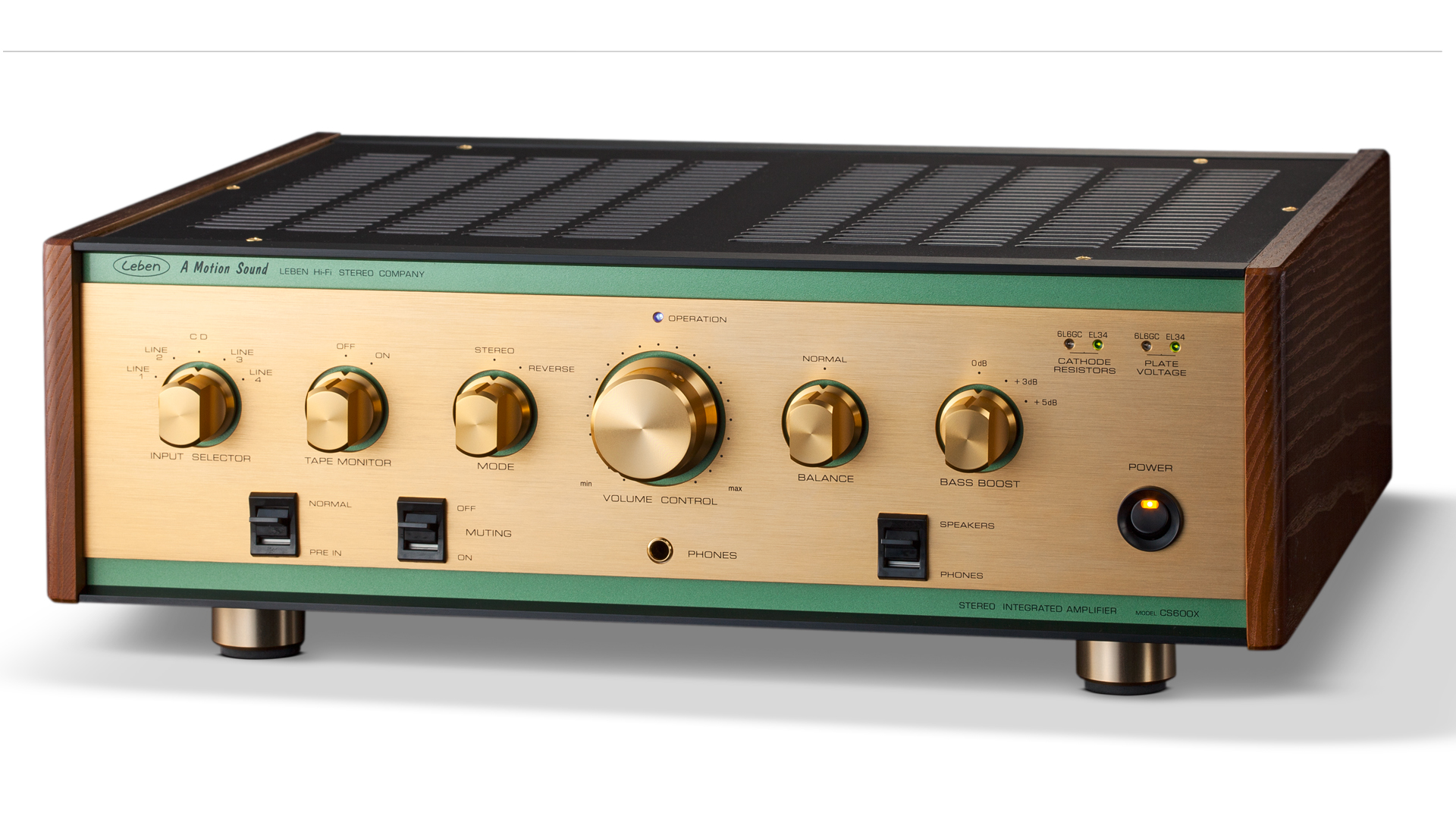What Hi-Fi? Verdict
Pamper the Leben CS600X and you have one of the most musically beguiling integrated amplifiers money can buy
Pros
- +
Detailed and expressive sound
- +
Beautifully made
- +
Lovely to use
Cons
- -
No remote
- -
Speaker matching requires care
Why you can trust What Hi-Fi?
Leben’s CS600X integrated amplifier could be described as distinctly retro, if you’re being polite, or old-fashioned if you aren’t. The mix of wooden side cheeks, glowing gold front panel and valve circuitry certainly harks back to times long gone. But is that a bad thing? We’re not so sure, particularly when the product is as talented as this.
Leben isn’t a particularly well-known manufacturer. Founded in 1992 by an ex-Luxman engineer, this small Japanese company hand-makes a small range of valve-based amplifier products in limited numbers. The current product range includes a pre/power combination, a phono stage and, of course, integrated amplifiers, of which the CS600X is the range-topper. It’s a line-level-only unit, so if you play records or need digital inputs, you’ll need to budget for extra boxes to do those jobs.
Build

The CS600X is no powerhouse, as the 28W per channel output figure shows. If you want to drive inefficient speakers, or need high volume levels in large spaces, this is not the amplifier for you. But if nuance matters more than muscle, and you’re prepared to pamper this amplifier with sympathetic speakers, it’s capable of turning in a terrifically musical performance.
Take a look inside that well-constructed casework and you’ll find that this is a push-pull device that comes with a quartet of EL34 output valves as standard. Part of the appeal of this product is that it is easy to change those to 5881 valves and raise the output to 32W per channel.
That marginal increase on poke isn’t the reason to make the swap though. Changing valves affects the sonic signature of the amplifier, so it’s possible to fine-tune the CS600X’s sound to your tastes. There’s a pair of internal toggle switches that change the circuit conditions to allow the output valve swap to happen.

Line-level inputs x5
Phono stage No
Tape loop Yes
Headphone output 6.3mm
Power output 28W per channel
Dimensions (hwd) 14 x 45 x 36cm
Weight 23kg
It doesn’t stop there. Read the manual and you’ll find that the CS600X can also be used with all types of output valves from KT66/77/88s to 6550As. This kind of flexibility is extremely rare and those who like to tweak are in for a treat here.
This ability to accept a wide range of valves also makes any assessment of this product less precise than usual, because the sound can be tweaked so much. With this in mind, we’re concentrating on the CS600X as it comes out of the box, and that’s with the EL34s.
The latest hi-fi, home cinema and tech news, reviews, buying advice and deals, direct to your inbox.
Elsewhere, you’ll find two 12AU7A and two 12BH7A small signal valves used in the line stage, and a 6CM3/6DN3 in the power supply section. With all those tubes running inside, this amplifier gets pretty hot so make sure it has plenty of ventilation.
Overall build quality is truly excellent. This product feels reassuringly solid and has the air of something built to last decades. Every control has substance and precision, while the chassis has an impressively chunky feel. We love the quality of the gold finish on the front, and the way the solidity of the casework inspires confidence. The wooden side panels are made of Canadian white ash, chosen for its hardness and mass – it’s often used to make baseball bats or rowing oars. Overall, this Leben is an expensive product and feels it too.
That said, on purely aesthetic grounds we can’t help feeling that the trio of chunky plastic switches for muting, switching between speakers and headphones, and changing the CS600X from integrated to power amp mode look a little out of place next to the immaculately crafted metal rotary controls. The same applies to the power switch that looks like it belongs on some small computer appliance rather than a high-end valve amplifier. But this is a purely appearance-based judgment on our part, and you might disagree.
Take a close look at the CS600X’s front and you’ll find a number of unusual controls. Alongside the usual volume, balance and input selector controls there’s also a two-step Bass Boost and a stereo reverse function that inverts the signal phase 180 degrees. In some systems, the inverted phase could give more focused results.
Features

Provided line-level inputs are fine for you there’s little to complain about on the features front. The CS600X is surprisingly accommodating for a product of this type, with no less than five single-ended inputs, a tape loop for anyone who still records and a direct feed into the power amplifier section for those who want to bypass the integrated preamp circuitry.
Above the single set of speaker outputs, there’s a rotary control to match the nominal impedance of the partnering speakers. The adjustment covers 4, 6, 8 and 16ohm options. While it makes sense to start with the control set at the value of your speakers, there’s no harm in trying any of the other settings. It’s possible that the slightly different sound it brings may be preferable.
This is an amplifier that needs care in partnering so you can hear just how good it can be. An output of just 28W per channel means the Leben is no powerhouse, so we’d go for relatively sensitive speakers that are easy to drive. While we suspect that the CS600X would excel with one of the bigger horn-loaded speakers around, we still get good results with the likes of Wilson Benesch’s Precision P2.0 and KEF’s LS50 Meta.
Our reference ATC SCM50 speakers don’t fare so well – the combination produces fine sounds from the midrange upwards but suffers from soft low frequencies and restrained dynamics. No wonder, given the SCM50’s low 85dB/W/m sensitivity and ability to soak up the watts.
The best option turns out to be partnering the Leben with ProAc’s Award-winning Response D2R standmounters. This pairing produces sweet, well-balanced and entertaining results.
But that isn’t what we hear initially. Our CS600X unit takes the best part of a week before it starts to sing – until then, the results are congested, rhythmically stunted and dynamically restrained. If you hear this amplifier sound anything like this, give it at least a week of use before you judge it. After that time it will shine.
Sound

Anyone expecting the typical soft and rich valve sound will be in for a surprise. If partnered with care, this is a relatively taut, punchy-sounding performer, particularly when compared with other valve designs. We’re a little surprised to be listening to Kanye West’s Yeezus set and enjoying ourselves.
This is an integrated amp with enough guts and punch to charge along to New Slaves, delivering the song’s hard-charging beat with a fair bit of conviction. It’s far better than most valve alternatives we’ve come across in this respect, though it still falls short of giving the likes of rhythm and timing champs Naim sleepless nights. That said, it’s certainly good enough for us to tick those boxes and move on.
Switch to other kinds of music and the Leben’s excellence comes to the fore. We listen to Debussy’s Clare De Lune and fall in love with the piece all over again. Rarely do we hear an amplifier at this level that sounds so clear and expressive. Dynamic nuances are explored rather than ignored and the centrepiece piano is rendered with its harmonic richness and musical coherence intact.
Most transistor-based alternatives sound tonally grey and dynamically bland in comparison. We love the way this amplifier renders instruments in such a palpable and full-bodied way, making them sound more lifelike than a recorded facsimile.
This rings true when we switch to Nina Simone’s My Baby Cares For Me, where the Leben sounds positively enchanting, delivering Simone’s powerful and distinctive voice with all the power, finesse and expression it deserves. All the time, the backing instrumentation is organised and energetic.
Larger scale recordings such as Mahler’s Symphony No.2 are handled almost as well. We love the natural way this Leben renders instrumental textures. Its detailed yet fluid delivery is utterly convincing, as is the way the acoustic information that defines the recording venue is described. There’s little to complain about when it comes to scale (with appropriate speakers, of course), but it’s certainly possible to get a more authoritative presentation and higher volume capability at this level.
We give the CS600X’s headphone output a listen with a pair of Grado RS1 and Beyerdynamic’s T1 Mk2, and are really impressed. The amplifier sounds crisp and clear through headphones, retaining all the finesse and insight we so enjoy through the speaker outputs.
It seems odd to talk about compromises at this price level, but they exist at all levels to some extent. If you have this kind of money to spend on an integrated amplifier, you can buy rather fine examples, such as the Krell K-300i or Mark Levinson’s No.5805.
Both of these are far better equipped, with digital inputs, optional streaming modules and even Bluetooth on the menu, and that’s without mentioning three-figure power outputs that are capable of driving pretty much any speaker to high levels. These are powerful tools that bludgeon recordings and partnering speakers into submission, but perhaps lose a little charm in the process. That sonic charm is something that the Leben has aplenty.
Verdict
The CS600X doesn’t chase the same customer. Anyone seriously thinking of buying one will love its simplicity and the sheer joy of operating something so tactile. The lack of remote control won’t be an issue, and neither will the need to take care with speaker matching.
Such a customer would revel in the amplifier’s clarity and exceptionally nuanced dynamic behaviour, while overlooking its relative shortcomings. Having spent considerable time with this amplifier we could well do the same. Consider us smitten.
SCORES
- Sound 5
- Features 4
- Build 5
MORE:
Read our guide to the best stereo amplifiers
Read our Krell K300i review
Read our Mark Levinson ML5805 review
Read our PMC Cor review
What Hi-Fi?, founded in 1976, is the world's leading independent guide to buying and owning hi-fi and home entertainment products. Our comprehensive tests help you buy the very best for your money, with our advice sections giving you step-by-step information on how to get even more from your music and movies. Everything is tested by our dedicated team of in-house reviewers in our custom-built test rooms in London, Reading and Bath. Our coveted five-star rating and Awards are recognised all over the world as the ultimate seal of approval, so you can buy with absolute confidence.

